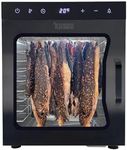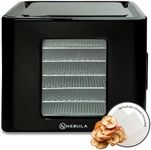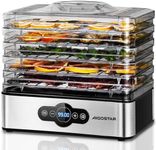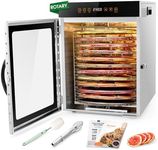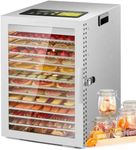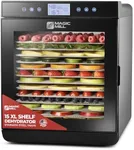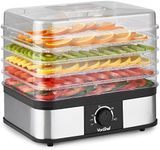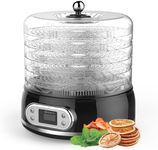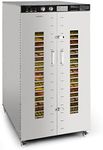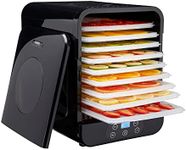Buying Guide for the Best Dehydrators
Choosing the right dehydrator can make a big difference in your food preservation and preparation process. Dehydrators are used to remove moisture from food, which helps in preserving it for longer periods and can also enhance flavors. When selecting a dehydrator, it's important to consider several key specifications to ensure you get the best fit for your needs. Here are the main specs to look at and how to navigate them.CapacityCapacity refers to the amount of food you can dehydrate at one time. This is important because it determines how much food you can process in a single batch. Dehydrators come in various sizes, from small units suitable for occasional use to large models designed for heavy-duty processing. If you plan to dehydrate large quantities of food or have a big family, a larger capacity model would be ideal. For occasional use or smaller batches, a compact model should suffice.
Temperature RangeThe temperature range of a dehydrator indicates the different heat settings it can achieve. This is crucial because different foods require different drying temperatures to preserve their nutrients and flavors. A wider temperature range offers more versatility, allowing you to dehydrate a variety of foods, from herbs and fruits to meats. If you plan to dehydrate a diverse range of foods, look for a model with a broad temperature range. For specific uses, such as just drying fruits, a narrower range might be adequate.
Airflow and Heat DistributionAirflow and heat distribution refer to how evenly the dehydrator can dry food. This is important because uneven drying can lead to inconsistent results and potential spoilage. Dehydrators typically use either vertical or horizontal airflow. Vertical airflow models are usually more compact and affordable but may require rotating trays for even drying. Horizontal airflow models tend to provide more uniform drying without the need to rotate trays. If you want hassle-free and consistent drying, a horizontal airflow model is a good choice. For occasional use and smaller batches, vertical airflow models can be sufficient.
Number of TraysThe number of trays in a dehydrator determines how much food you can dehydrate at once and how flexible the unit is in terms of capacity. More trays mean you can dehydrate more food simultaneously. Some models offer expandable trays, allowing you to add more as needed. If you plan to dehydrate large quantities or different types of food at the same time, look for a model with more trays or expandable options. For smaller batches or single-type food dehydration, fewer trays will work just fine.
Noise LevelNoise level refers to how loud the dehydrator is during operation. This is important if you plan to use the dehydrator frequently or overnight, as a noisy unit can be disruptive. Dehydrators with fans tend to be noisier than those without. If noise is a concern, look for models that are specifically designed to operate quietly. For occasional use or if the noise won't bother you, this may be less of a priority.
Ease of CleaningEase of cleaning is about how simple it is to clean the dehydrator after use. This is important because dried food can leave residues that need to be cleaned to maintain hygiene and performance. Models with removable trays and dishwasher-safe parts are easier to clean. If you want to minimize cleaning time and effort, look for a model with these features. For those who don't mind a bit of extra cleaning, this may be less critical.
Additional FeaturesAdditional features can include things like timers, automatic shut-off, digital controls, and preset programs. These features can add convenience and improve the overall user experience. Timers and automatic shut-off can prevent over-drying and save energy. Digital controls and preset programs can make the dehydration process more straightforward. If you value convenience and ease of use, look for models with these additional features. For basic dehydration needs, a simpler model without these extras may be sufficient.
